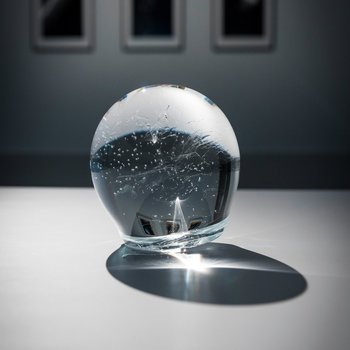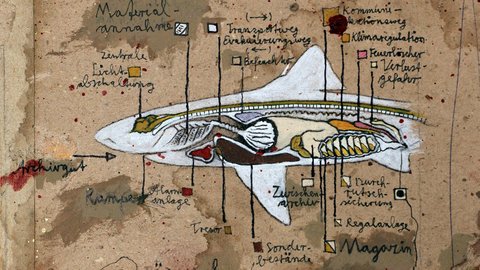
Plakatausschnitt: "Die Hüter des Unrats"
© Susann Maria Hempel
Früher einmal war der Müll das Gegenteil des Archivs, die Gesamtheit der Lücken des Archivs bzw. alles, was den Archiven abging: das ANARCHIV. Durch eine scheinbar simple, „archivarische Geste“ ließ es sich jedoch selbst zu einem ANDEREN ARCHIV deklarieren, das so „tief hineinreicht in das intimste, geheimste Leben der Menschen“ wie kein anderes, „denn jede Handlung, jede Bewegung hinterliess in ihm ihre Spur, den unleugbaren Beweis dafür, dass sie geschehen war“ (Tournier, Michel: Zwillingssterne). Damit mauserte sich der Müll zum GROSSEN BEWAHRER DER DINGE, der zukünftigen Archäologen die Hinterlassenschaften unserer Zivilisation zu vererben versprach.
Die Deponie verwandelte sich in ein nachtseitiges Speichergedächtnis, das darauf wartete, wiederentdeckt und interpretiert zu werden. „Wegwerfen“ wurde gleichbedeutend mit „Archivieren“: denn wer Abfall produzierte, wirkte gleichsam an der Ausgrabbarkeit der künftigen Vergangenheit der Gegenwart mit. Nachher, ja, nachher - hätten noch die belanglosesten Dinge Bedeutung gehabt! Wäre da nicht das Paradox des wertvollen Mülls aus der klebrigen Abfallmasse gekrochen...
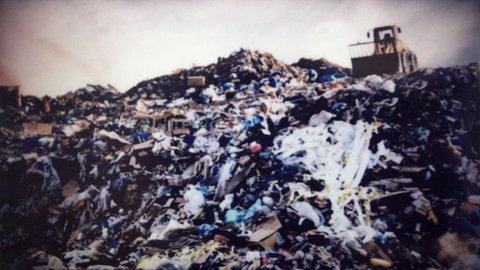
Filmstill aus Susann Maria Hempels "Die Hüter des Unrats"
© Susann Maria Hempel
Als die Dinge ihre abgenutzte Gestalt aufgaben zugunsten der Wiederverwertbarkeit ihrer Materialität, begann die Gegenwart für die Zukunft zu verschwinden, d.h. sich um die Belege ihres Dagewesenseins zu bringen. Recyclebaren Dingen widerstrebt es, bewahrt (deponiert) zu werden, sie wollen aufgehoben werden im Transformationsprozess ihrer Wertstoffmasse! Wenn sich also Kreislaufwirtschaftskonzepte in die Unendlichkeit von Recyclingprozessen hineinträumen, dann um den Preis des totalen Verlusts des Gedächtnisses der Dinge, ihrer Form und Gebrauchsgeschichte.
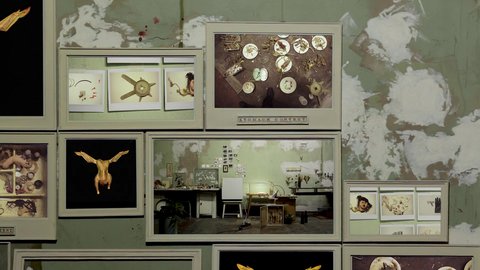
Filmstill aus Susann Maria Hempels "Die Hüter des Unrats"
© Susann Maria Hempel
Den Kringeln dieses prospektiven Gedächtnisverlusts trotzt aber der sogenannte FEHLWURF. In manchen Ländern der Bundesrepublik wird er mit Bußgeldern geahndet. Hier und da wird er von Überwachungskameras beobachtet oder von einer Art Müllpolizei verfolgt, die prüft, ob alles im richtigen Container landet. Global betrachtet gibt es jedoch einen gigantischen Behälter zur Aufbewahrung weltweit fehlgeworfener Materie: das Meer...
Eine Unzahl mobiler Archivschachteln bevölkert die Untiefen der Ozeane: dort sind Tonnen von Müll in Tieren und ihren Mägen hinterlegt; sie geben den herrenlos umhertreibenden Abfällen der menschlichen Spezies eine Bleibe und dienen ihnen gleichsam als Gedächtniskoffer.
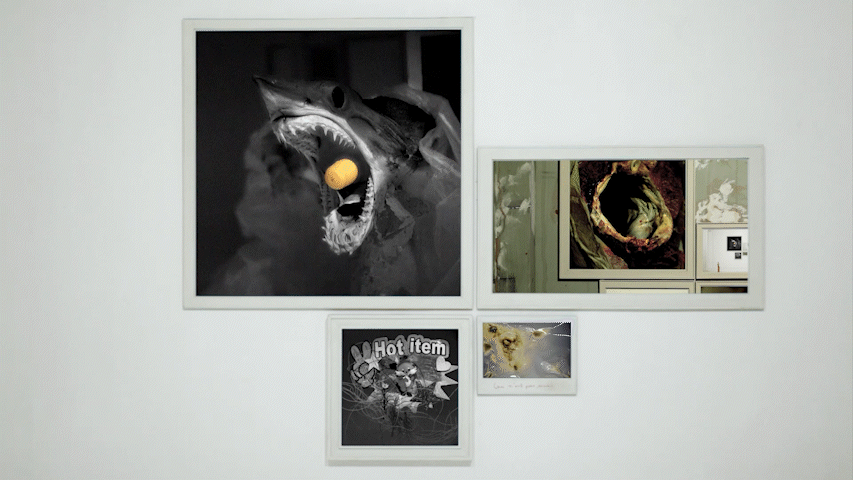
Ausschnitt aus Susann Maria Hempels "Die Hüter des Unrats"
© Susann Maria Hempel
Zeit seines Lebens ist das Tier ein recht verschlossenes MUSEUM IN A BOX; es betreibt zunächst ein wenig Geheimniskrämerei. Denn was es verschlingt (und nicht wieder ausscheiden kann), behält das Tier zunächst FÜR SICH. In seinem Innersten legt es ein Müllarchiv an. In der blackbox des Magens ist seine Sammlung von einem VERWAHRENSVERGESSEN ummantelt, mit der es heimlich durch die Zeit und die Meere schippert: erst, wenn das Tier sich „lichtet“, also wenn es verwest, offenbart sich sein ARCHIVGUT, bzw. sein ARCHIVÜBEL.

Ausschnitt aus Susann Maria Hempels "Die Hüter des Unrats"
© Susann Maria Hempel
Es verhungert mit vollem Magen.
Das Gedärm trifft die Archiventscheidung für Bewahrung oder Kassation, d.h. alles, was sich nicht zerkleinern, ausscheiden und somit erneut über die Meere verteilen lässt - um anderswo von anderen Organismen aufgenommen zu werden - erhält eine dauerhafte Bleibe im Verdauungstrakt, der zuverlässig jenen Abfall hortet, den das Tier mit Nahrung „verwechselt“.
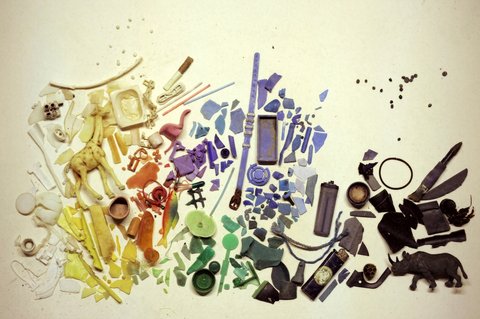
Mageninhalt
© Susann Maria Hempel
Sagt man so. Aber eine Verwechslung setzt gemeinhin Unterscheidbarkeit voraus. So dass das Eine als das Andere verkannt werden kann, und umgekehrt. Eine Schildkröte macht aber gerade zwischen einer Tüte und einer Qualle keinen Unterschied. Archiviert wird somit auch die Ununterscheidbarkeit lebendiger Organismen von leblosem Müll. Es ist alles eins. Nicht einmal das Sterben erinnert an Etwas. Es gibt keine Erleuchtung, kein zu spät kommendes Wissen („Ach, hätte ich bloß die Zahnbürste nicht gegessen!“), nur unbegreifliches Leid und etwas radikal Fremdes, das „ordentlich im Leibe rumpelt, wie es im Märchen heisst.“ (Nietzsche, Friedrich: Unzeitgemäße Betrachtungen II).
Oder leidet das Tier am Ende mit Berechnung? Der Inhalt heiligt die Verpackung! Und im nächsten Märchen wird der liederliche Knochenhaufen mit all dem wertvollen Müll in seiner Mitte zum wertvollen Reliquiar befördert. Zum Silbermöwenschrein oder zum Rotbarschostensorium; zum Flügel- oder Flossenreliquiar: Tiere und ihre Magenarchive werden somit zu Teilnehmern einer archivologisch motivierten INTERSPEZIES-KOLLABORATION, sie übermitteln die unverdaulichen Reste menschlicher Gegenwart an die Zukunft und sterben für die Wiederaufindbarkeit der Vergangenheit.
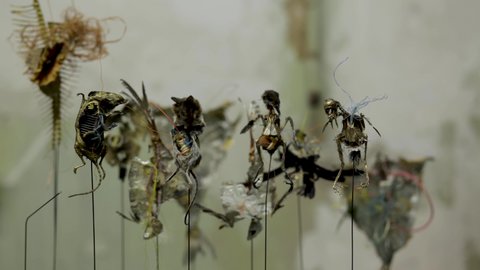
Filmstill aus Susann Maria Hempels "Die Hüter des Unrats"
© Susann Maria Hempel
Auch interessant:
Jedes Jahr verleiht die Deutsche Akademie Rom Villa Massimo den Rompreis an neun ausgewählte Künstler*innen, denen damit ein zehnmonatiger Aufenthalt in Rom ermöglicht wird. Die Arbeiten der beiden letzten Jahrgänge sind dieses Jahr im Japanischen Palais in der Ausstellung "Eppur Si Muove - Und sie bewegt sich doch" ausgestellt. Angela Windholz stellt das Haus und sein Programm vor.
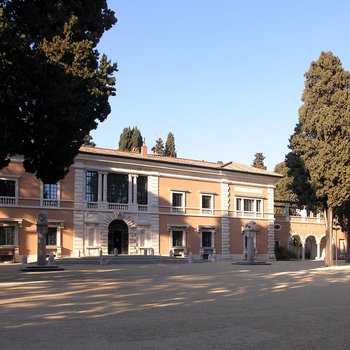
Einwegbestecke aus Plastik sind ein Symbol für die globale Wegwerfgesellschaft. Seit 3. Juli 2021 sind sie in der EU verboten. Die auf der Basis der Sammlung der Designer Peter Eckart und Kai Linke entstandene Ausstellung „Spoon Archaeology“ im Kunstgewerbemuseum greift das Thema auf.
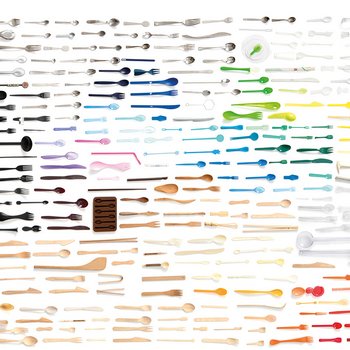
Marijke van Warmerdams Arbeit Eiskugel – buchstäblich eine Kugel aus Eis mit einem Durchmesser von 25 cm – ist ein bescheidenes Werk, das vielleicht etwas zu einfach gestrickt wäre, wenn es nicht langsam in der Galerie schmelzen würde. Jane Boddy über die enorme Energie, die in der Herstellung eines durchsichtigen, geschnitzten Eisstücks steckt, das gegenwärtig auf der Kinderbiennale "Embracing Nature" im Japanischen Palais zu sehen ist.
